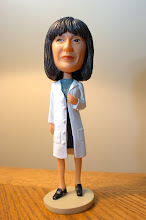 Like last week's fermenting friend Lactobacillus, Saccharomyces is a very helpful little bug. Saccharomyces is a eukarotic, osmophillic yeast. And while there are many species in this genus, the most studied, and most used species is S. cerevisiae.
Like last week's fermenting friend Lactobacillus, Saccharomyces is a very helpful little bug. Saccharomyces is a eukarotic, osmophillic yeast. And while there are many species in this genus, the most studied, and most used species is S. cerevisiae.Fermentation using yeasts has been around for some 4000 years with evidence of breads and beer being found in Egyptian tombs. Yeasts are what turn dough into bread, malt into beer, molasses into rum, grapes into wine and rice into sake.
While the actual definition of fermentation, as I stated previously, is the breakdown of carbohydrates under anaerobic conditions, a common definition is the breakdown of sugars into carbon dioxide and alcohol under aerobic conditions. Saccharomyces species multiply better under aerobic conditions (which was used to great advantage by Charles Fleischmann in 1868 to produce the first commercially available yeast) but ferment better under anaerobic conditions like in a dough.
Obviously alcohol is not the by-product of fermentation we are looking for in bread; its the carbon dioxide that we want for leavening. However, the alcohol produced helps extract flavor compounds that are not water soluble and creates some of the characteristic flavors associated with baked bread. Saccharomyces cerevisiae is also known as baker's yeast and it is what you buy in those little envelopes at the grocery store.
Alcohol is what we want when making wine and beer, with the carbon dioxide adding a nice fizz. Saccaromyces ellipsoideus is used to ferment grape juice into wine. while two different species are used in beer manufacturing depending on what you are brewing. Saccharomyces cerevisiae is a top fermenter (top of the vessel) and produces ales while Saccharomyces pastorianus is a bottom fermenter and produces lagers. Yeasts are also used in the production of industrial ethanol for fuel.
So, what to take away from all of this? Well, how about that microorganisms can be your friend as well as your enemy and that they can make what we eat more fun to eat.






No comments:
Post a Comment